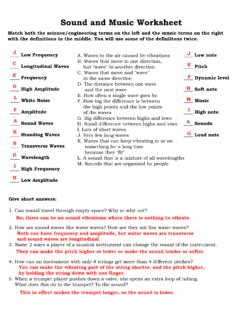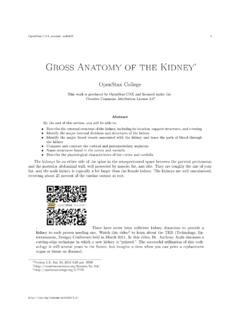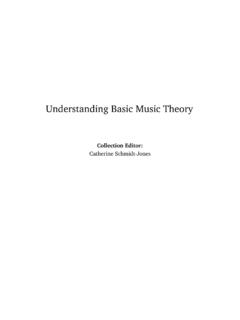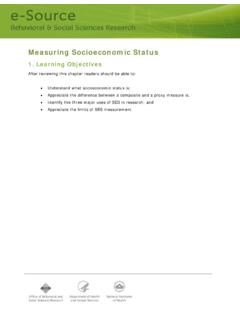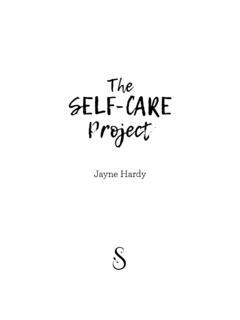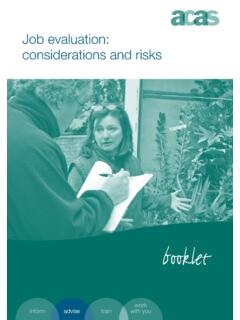Transcription of Life Orientation Grade 8 - CNX
1 life Orientation Grade 8. By: Siyavula Uploaders life Orientation Grade 8. By: Siyavula Uploaders Online: < >. CONNEXIONS. Rice University, Houston, Texas This selection and arrangement of content as a collection is copyrighted by Siyavula Uploaders. It is licensed under the Creative Commons Attribution license ( ). Collection structure revised: September 12, 2009. PDF generated: October 28, 2012. For copyright and attribution information for the modules contained in this collection, see p. 85. Table of Contents 1 Term 1. Self-image .. 1. Personality traits .. 4. People di er .. 7. Are you a winner .. 10. 2 Term 2. How to express emotions .. 15. Not everone experiences stress in the same way .. 16. Eustres and distress .. 18. Stress factors (the right module0 .. 20. Stress symptoms .. 22.)
2 A healthy lifestyle in handling stress .. 25. The value of exercise .. 28. Personal stress .. 29. The school and stress .. 31. Hints on handling stress .. 33. 3 Term 3. What is true health? .. 37. Why is play important? .. 38. The value of rules .. 40. Designing a game with spesi c rules .. 41. Designing a game with spesi c goals .. 42. Planning an adventurous extramural activity .. 44. Investigating gender equality .. 50. 4 Term 4. Human reproduction .. 51. People need people and to interact with the environment .. 53. Individual rights and responsibilities .. 55. Apply individual rights and responsibilities in everyday situations .. 57. The norms and values that apply in the community .. 61. The causes of particular diseases in terms of environmental factors .. 65. Kindsof careers and the nature of the work.
3 69. The personalities of people in di erent careers .. 71. Subject choices that are suited to particular careers .. 73. Career opportunities .. 75. The Bill of Rights .. 78. Attributions .. 85. iv Available for free at Connexions < >. Chapter 1. Term 1. Self-image 1. life Orientation . Grade 8. SELF-ESTEEM. Lodule 1. SELF-IMAGE. Hi there! Have you ever had the feeling that you do not quite belong? I'm talking real life here. For example: a thirteen year old attends a party where everybody else is over 20 years old. Most thirteen year olds will feel a bit uncomfortable, don't you think? At the start of your high school career, some of you may feel unsure about where you belong. At the end of last year, you were the "big brothers and sisters" of the primary section. Now, you are at the bottom of the pecking order again!
4 What may complicate things further is the fact that some of you may be more mature than others - and you want to hook up with the older kids - but they are wary and still checking you out. That's when one wonders: Where do I belong? It is crucial at times like these that you have a strongly positive, but realistic self-image. Your self-image is what you think of yourself. A person's self image is formed by what other people say to you and about you - and also how they act towards you. The people who initially in uence your life are your family members. When you go to school, your teacher's opinion and those of your class mates become important to you. When you are a teenager, the opinions of your friends are extremely important to you. Other factors kick in: What do I look like? Am I smaller or bigger than my friends?
5 Do we have the same status? Am I clever? Am I good at sport? Am I. popular? At this stage of your life you are inclined to measure your own worth according to standards which the peer group sets - and which are enforced by the media (You are what you ). That is part of life . But if you are one of those rare individualists who believes in doing your own thing - it is a good idea to master and practise the art of positive self talk. But more about this later. 1 This content is available online at < >. Available for free at Connexions < >. 1. 2 CHAPTER 1. TERM 1. Group Discussion Guidelines to help the group discussion succeed Take turns to speak. When one person is speaking, everyone else listens. Keep each contribution short so that everyone can participate. Help the shyer group members by asking them questions.
6 It is natural to have di erent viewpoints, but respect each person's opinion. Keep the time allocated for this discussion in mind. TOPIC FOR DISCUSSION:In which ways does this year di er from last year? How do you feel about the changes or di erences? After the discussion What did you learn? Was it a successful discussion? Did everyone participate? Write yes or no and give the reasons. In Write your own observations and feelings on the discussion topic. What do you experience as the biggest change and how does that make you feel? This is the way I Make use of words and sketches to show how you changed. Show the changes by drawing blocks, clouds or any other forms that represent you at three-year intervals in your life . Be as creative as you want to be. Di erent colours and shapes will make your work interesting and fun.
7 To complete the activity above, you relied mostly on your right brain functions (the more creative side). Now use a structured approach to give the same kind of information. Your left brain functions are more structured and logical. Here is an example below. Complete it, please. 3 years 6 years 9 years 12 years Weight: 25kg 38kg 45kg 60kg Table The little dog who always gets the hind If you ever had puppies from birth to when they are weaned, you would have noticed that one of them often is pushed away and has to be content with a less favoured teat - not the teats that are full of milk. Such a puppy can turn into a scrawny, uncertain pup or becomes a real tough little scrapper who ghts for each morsel. What on earth do puppies have to do with self image? Think again and read between the lines.
8 Available for free at Connexions < >. 3. There are often times when we feel we do not get our fair share. How do you react if you feel that way? Let's look at some questions surrounding the idea of a healthy self-image or self-concept. Answer as honestly as you can and remember, you may feel di erent on "bad hair days", those days when nothing goes according to your plans. Answer only always, sometimes or never. 1. If I make a mistake, I feel terrible. 2. I easily adapt to new circumstances. 3. I make friends easily. 4. People like me. 5. I like new challenges. 6. I am honest. 7. I am a leader. 8. I have my own style (of doing, etc.). 9. People listen to what I have to say. 10. I feel I am special. Relax, these are not "right or wrong" type of answers. If you answered "always" in all cases, you possibly have a strongly positive self-concept.
9 If you answered "never" in all cases, you may need to work on your self-con dence. Look at number 1. An "always" here may indicate that you are a perfectionist and that you do not tolerate your own mistakes or those of others well. Chill. How does a person learn? Through trying. And if one tries, one will make mistakes. Therefore, making mistakes is part of the learning process- and not something to avoid at all cost! Group Discussion Do you still remember the guidelines set for successful discussions? Read the guidelines again and please use them. TOPIC FOR DISCUSSIONW hich factors in uence the self-image or self-concept of people? After the discussion List the factors which you discussed and mark those which in uence you with an *. What did you learn? Are all factors equally important to everyone?
10 If somebody thinks he or she is unattractive, looks will be an important factor in that person's life . If someone feels that he or she is poorer than his friends, it may in uence that person. Should it really? A person from a happy home may have a more positive self-concept than somebody from an unhappy home. What do you think? What about a person who has trouble making friends? Or someone who has to attend a new school? Some factors may be more temporary than others. (A person is not going to stay "new" at a school ). [LO ]. Assessment Learning outcomes(LOs). continued on next page Available for free at Connexions < >. 4 CHAPTER 1. TERM 1. LO 3. Personal developmentThe learner will be able to use acquired life skills to achieve and extend personal potential to respond e ectively to challenges in his or her world.
